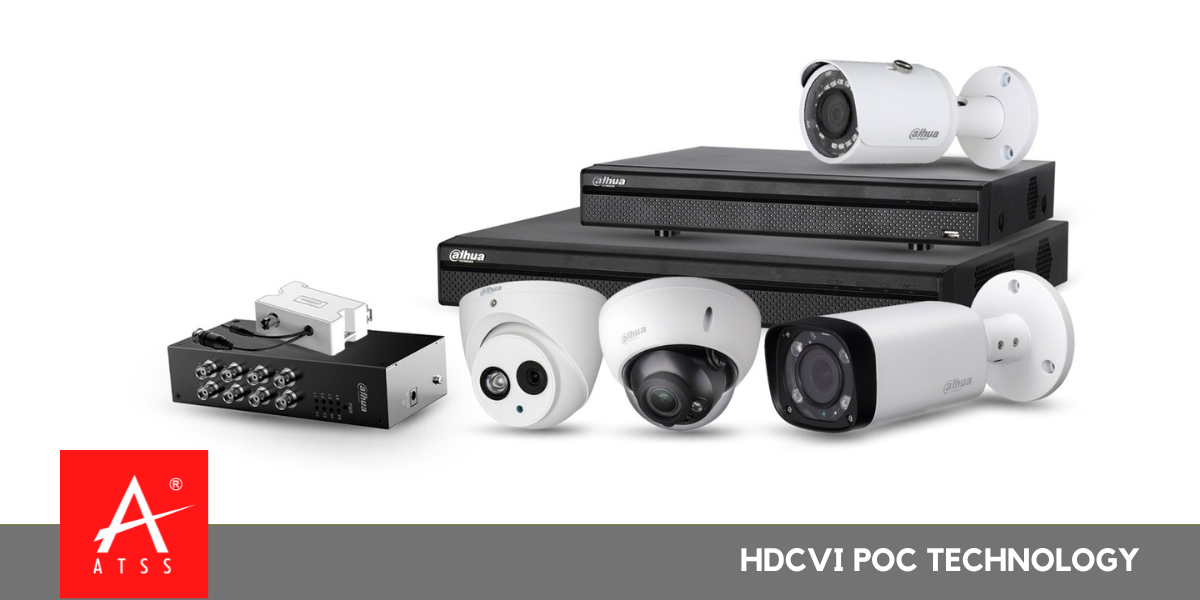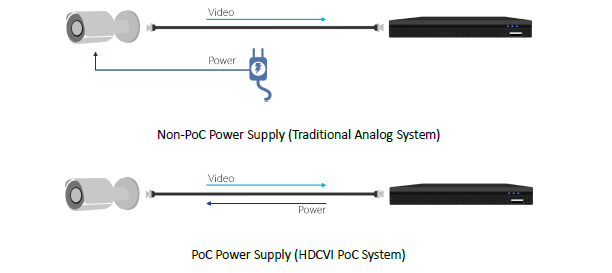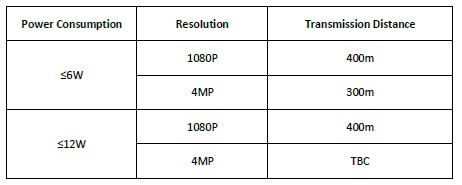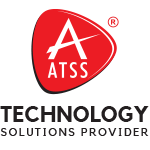
HDCVI PoC Technology
Dahua CCTV Cameras – DAHUA HDCVI PoC Technology Save up to 30% on System Deployment Costs.
Dahua CCTV Cameras – Dahua, a leading solution provider in the global video surveillance industry, has simplified the installation of the HDCVI surveillance system with its Power over Coax (PoC) technology, which transmits both video, audio, control signal, and electrical power over one single coaxial cable, eliminating the need for separate camera power supplies and minimizing operation costs.
Dahua CCTV Cameras – When Deploying a video surveillance system, labor costs take up a significant proportion of total expenditures. In the case of relatively low-cost HD analog systems, labor costs can comprise half or even more than half of the total system cost as the installation for each point must be designed and performed manually. Adding to the total workload is the fact that each camera must be independently supplied with power. As a result, contractors and installers continuously seek ways to reduce labour costs in order to increase efficiency and earnings. However, they face a number of challenges.
If cameras are independently supplied with power, each point must be designed and configured with a power supply, plugs and cables. In scenarios which require a relatively large number of devices, this significantly increases the costs and workload and after-installation maintenance of power supplies at each point must also be provided.
Even if cameras are powered by a centralized power supply, each point still requires extra design and cabling work. At the same time, if poor quality materials are used, or the distance of power transmission is too great, it could cause an increase in voltage drops, resulting in the centralized power supply not being able to satisfy device requirements for normal operations.
HDCVI PoC (Power over Coax) technology delivers power to cameras over the same single coaxial cable used for video transmission. This eliminates the extra design, installation, and maintenance required by independent camera power supplies, allowing contractors, installers, and end users to save labor and costs.
KEY TECHNOLOGY
Dahua CCTV Cameras – HDCVI PoC technology is the hybridization of a traditional HDCVI signal (including video, audio, and control signals) and a power source, allowing for the transmission of data and power over a single coaxial cable. This technology achieves the direct supply of power to the camera from storage devices or PoC transmitters via coaxial cable. Cameras connected over PoC do not require additional power sources as in traditional analog systems.

HDCVI PoC Technology supplies power over coaxial cable at distances of up to 400m. It also supports cameras with a rated power of up to 12W, allowing HDCVI PoC cameras to fully support motorized zoom and longer IR ranges. Resolutions and maximum power consumption over specific transmission distances supported by HDCVI PoC can be viewed in the chart below.

There are a few key factors involved in achieving power supply over coax. The first is reducing power loss encountered during transmission via coaxial cable, which satisfies requirements for both increased transmission distance as well as cameras with higher power ratings. The second is to isolate video signals from the power current to avoid interfering with the video image sent from powered cameras. Power supply technology also needs to take the safety of its user into consideration and circumvent the risks to personnel and device fire hazards associated with the connection of non-PoC devices to system short-circuiting.
HIGH-LOW VOLTAGE CONVERSION
The process of delivering power over coax is as follows: the power supplying device first outputs a high voltage signal and transmits it via coaxial cable. When the signal reaches a power receiver (camera device) it is converted to DC12V and used to power camera operation. In theory, the higher the transmitted voltage, the longer the maximum transmission range and the larger the power receiving end’s supported device power rating. However, in actuality, higher transmission voltages lead to a significant increase in the cost and volume of PoC devices. Therefore, it is important to choose the most optimal transmission voltage possible to fulfill demand. The HDCVI PoC XVR transmits DC48V and the PoC transmitter transmits DC52V.
POWER ISOLATION
Because the video signal and DC power supply transmitted over coaxial cable run in opposite directions, it is necessary for PoC technology to effectively resolve isolation issues presented by this configuration. The minimal effective frequency for the video signal is 25Hz, while the DC power supply is effective at a frequency of 0Hz. As both signals are extremely close in frequency, it is difficult to engage in isolation through the use of a singular inductor. HDCVI PoC uses a simulated inductor to achieve low-frequency isolation. In other words, it uses an analog circuit as an inductor to achieve the conduction of the DC power supply while blocking the video signal.

VIDEO & SIGNAL PROCESSING
When the load current in a PoC system undergoes a change (such as when a camera begins to zoom, focus, or enable its IR LEDs), the DC voltage will fluctuate, causing video abnormalities. HDCVI PoC technology implements a fluctuation detection circuit to detect and control fluctuation interference within the video signal. At the same time, HDCVI PoC technology uses a compensation circuit to compensate for the low-frequency signals within the video signal, ensuring the video signal transmitted within PoC systems and non-PoC systems is basically the same.
PoC systems must also guarantee that the reverse control signal ( the control signal sent to cameras by the XVR), flowing in the opposite direction of the video signal, is not affected. Because the video compensation circuit blocks the reverse control signal, HDCVI PoC technology imposes superposition and extraction methods on the reverse control signal to guarantee normal control over the coax.
LOAD RECOGNITION & PROTECTION
During PoC operation, DC Power is transmitted over coaxial cable at high voltages. To avoid causing damage to devices or personnel when a non-PoC device is connected to the system. HDCVI PoC has designed strict load recognition and protection mechanisms for its products, including load validity detection, load disconnection detection, excess current, and short circuit detection, and discharge circuits.
Load validity detection determines whether or not the power-receiving device is a valid device. When an invalid device is connected at the power-receiving end (such as non-PoC cameras, UTC controllers, optical transceivers, etc.) load validity detection will determine that it is unable to detect a valid device and will not supply power to the power-receiving end.
Load disconnection detection begins after the power-receiving device has been connected and the supply of power over the coax has been initiated. It continuously detects whether or not the power receiving end has been disconnected. As soon as the power receiving end is disconnected, the power supplying end will cease power supply and rapidly restores the voltage transmitted over the coaxial cable to safe levels via a discharge circuit.
Excess current and short circuit protection are used to detect the electric current running through the system. If the system current exceeds the current threshold (via causes of system short-circuiting such as line faults, improper operation, or human destruction) the power supplying end will cease power supply, thus preventing device and personal injury caused by overcurrent.
CAMERA POWER OUTPUT
In real-world surveillance scenarios, users may have also installed supporting devices near their cameras, such as pickups. Aside from resolving the problem of supplying power to surveillance devices, if PoC systems were able to also solve power supply requirements for surrounding devices as well, it would deliver even more convenience to its users. HDCVI PoC technology has implemented a camera power output feature into select products. PoC cameras that support this feature are equipped with a power-out connector that outputs a DC12V current with a max-rated power of 2W.
CONCLUSION
HDCVI PoC Technology achieves the simultaneous transmission of video signals and DC power over a single coaxial cable, significantly reducing the workload and costs involved in surveillance system deployment. HDCVI Supports 1080P 400m and 4MP 300m PoC transmission and ensures that video and control signals are not impacted by power transmission. HDCVI PoC systems provide cameras with stable input, guaranteeing system stability and reducing maintenance costs. In addition, HDCVI has developed sophisticated PoC system protection mechanisms which guarantee user equipment and personal safety via automatic detection and rapid power cutoff. This advantage makes PoC an ideal solution for the construction of complex surveillance system applications involving many devices at a significantly reduced cost.

